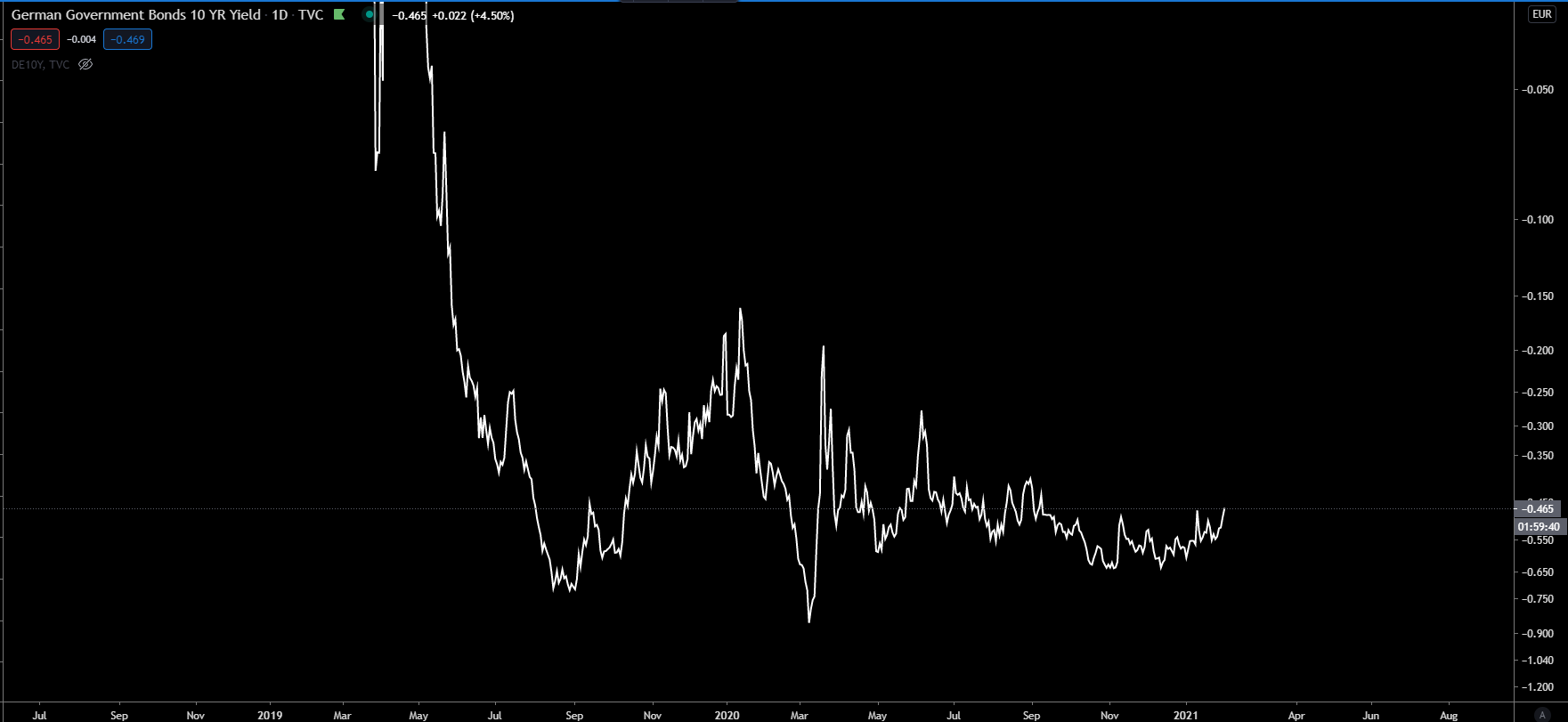Many are currently looking at the US 10-year yield rising and interpret it as a signal for global reflation. Slightly above 1.00% where the 10s yield currently sits (below) is a far cry from their pre-pandemic high of just under 2% in December 2019 and their high of about 3.25% back in October of 2018. However, if we pretend that just over 1% is actually as meaningful as the mainstream would like us to believe then we should be seeing a similar picture elsewhere. Let’s take a look at the German bund market because Germany is the world’s third largest exporter. Germany also exports a lot to emerging market nations. Therefore, if reflation is truly happening, it should be reflective in the German bund market with higher yields. So, let’s look specifically at the 10-year German bund yield which would be the German equivalent of the US 10-year yield. If you take a look (below, 2nd chart) at the 10-year German bund yield, you can see it has been pinned down since July 2020 and has shown very few signs that it wants to move higher. Now, I understand the euro has been strong which would make exports less competitive, but if reflation was really upon us, certainly the 10s bund yield would be rising, it would then just be a question of its rate of change.
If you take a look (below) at the 10-year US (white) and German (blue) yields, you can see over the last several months they have decoupled from each other. This is significant because if you look at the relationship between the two, they normally move in the same direction. Ironically, the last time they decoupled from each other was in 2018, the last time this reflation/inflation theme was producing as much noise as it is today. The year 2018 was a fake out for the US 10-y yield because after a few months of decoupling they rejoined the 10-y German yield to the downside. About a year and a half later, we entered into a global recession (March 2020). I recently spoke about the US 10-year yield as a leading economic indicator and as a more reliable predictor of what’s to come when compared to equities. It appears the 10-y German bund was an even better leading indicator than the US 10-y this last go around. Sure enough, just like in 2018, US 10-y yield has decoupled from the 10-y bund yield, heading upwards as the 10s bund yield remains on its downward trajectory. If recent history is to repeat itself, that would mean another move lower in US yields, likely being caused by another deflationary shock.
There is substantial risk associated with trading in the financial markets. You are solely responsible for your own financial decisions. Information on Ryan Miller Trading Economics is for educational purposes only. Ryan Miller Trading Economics will not be held responsible for any losses you incur. Ryan Miller Trading Economics does not provide any trading advice and is not a professional investment service. Past performance is not necessarily indicative of future results. There is a substantial risk of loss associated with trading currencies, securities, options, futures, equities and options on futures and currencies. Currencies, Futures, Options, Bonds, Equities and other securities trading all have large potential rewards, but they also have large potential risk and may result in monetary losses. You must be aware of the risks and be willing to accept them in order to invest or trade in these markets. Ryan Miller Trading Economics is neither a solicitation nor an offer to Buy/Sell currencies, futures, options, bonds, or equities. No representation is being made that any account will or is likely to achieve profits or losses similar to those discussed on this website. The past performance of any trading system or methodology is not necessarily indicative of future results.
Recommended Content
Editors’ Picks
USD/JPY holds above 155.50 ahead of BoJ policy announcement

USD/JPY is trading tightly above 155.50, off multi-year highs ahead of the BoJ policy announcement. The Yen draws support from higher Japanese bond yields even as the Tokyo CPI inflation cooled more than expected.
AUD/USD extends gains toward 0.6550 after Australian PPI data

AUD/USD is extending gains toward 0.6550 in Asian trading on Friday. The pair capitalizes on an annual increase in Australian PPI data. Meanwhile, a softer US Dollar and improving market mood also underpin the Aussie ahead of the US PCE inflation data.
Gold price keeps its range around $2,330, awaits US PCE data

Gold price is consolidating Thursday's rebound early Friday. Gold price jumped after US GDP figures for the first quarter of 2024 missed estimates, increasing speculation that the Fed could lower borrowing costs. Focus shifts to US PCE inflation on Friday.
Stripe looks to bring back crypto payments as stablecoin market cap hits all-time high

Stripe announced on Thursday that it would add support for USDC stablecoin, as the stablecoin market exploded in March, according to reports by Cryptocompare.
US economy: Slower growth with stronger inflation

The US Dollar strengthened, and stocks fell after statistical data from the US. The focus was on the preliminary estimate of GDP for the first quarter. Annualised quarterly growth came in at just 1.6%, down from the 2.5% and 3.4% previously forecast.


